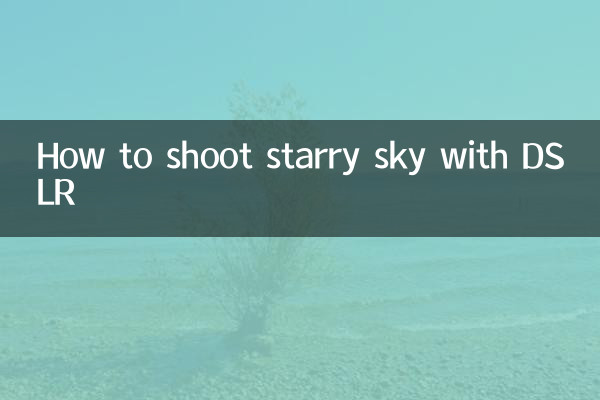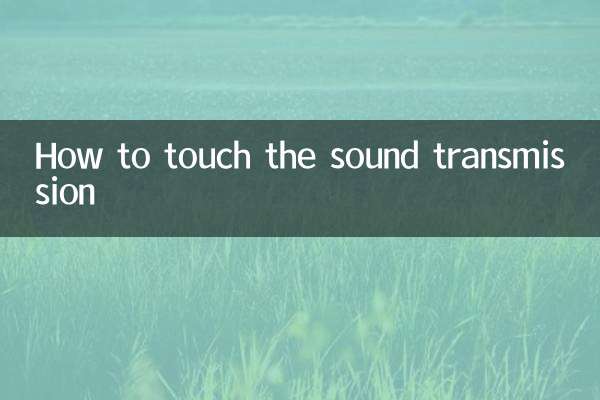How to shoot stars with DSLR: a complete guide from equipment selection to post-processing
Starry sky photography is one of the subjects that many photography enthusiasts yearn for, but if you want to take stunning starry sky photos, you need to master certain skills and preparations. This article will provide you with a detailed guide from equipment selection, shooting parameters, composition techniques to post-processing.
1. Hot topics and hot content on the entire network in the past 10 days

| Ranking | hot topics | heat index |
|---|---|---|
| 1 | Perseid Meteor Shower Observing Guide | 9.8 |
| 2 | The best starry sky shooting locations in 2023 | 9.5 |
| 3 | Comparison of mobile phone vs DSLR starry sky shooting | 9.2 |
| 4 | Post-processing techniques for starry sky photography | 8.9 |
| 5 | Galaxy Season Shooting Schedule | 8.7 |
2. Equipment selection
Photographing the stars requires specific equipment, but here are your best options:
| Device type | Recommended configuration | Remark |
|---|---|---|
| camera | Full-frame DSLR/Micro-SLR | A model with good high-sensitivity performance |
| lens | Ultra wide angle large aperture lens | Such as 14-24mm f/2.8 |
| tripod | Stable carbon fiber tripod | Essential anti-shake equipment |
| Other accessories | Shutter release cable, spare battery | Anti-fog belt optional |
3. Shooting parameter settings
Correct parameter settings are the key to successfully photographing the starry sky:
| parameter | Recommended value | illustrate |
|---|---|---|
| ISO | 1600-6400 | Adjust according to the camera's high-sensitivity performance |
| aperture | Maximum aperture or close one stop | Such as f/2.8 |
| shutter speed | Follow the rule of 500 | 500/focal length=maximum exposure seconds |
| white balance | Around 4000K | Can be adjusted later |
| focus | Manual focus infinity | Use LiveView to zoom in and confirm |
4. Shooting location and time selection
Choosing the right location and time to shoot is crucial:
| factor | suggestion | illustrate |
|---|---|---|
| light pollution | Choose a dark area | Use light pollution map query |
| weather | clear and cloudless | Pay attention to the weather forecast |
| Moon phases | Best around new moon | Moonlight affects starry sky visibility |
| season | The Milky Way is most visible in summer | The position of the Milky Way is different in different seasons |
5. Composition skills
Great starry sky photos require careful composition:
1. Include interesting foregrounds such as trees, rocks, or buildings to add depth to your photo
2. Try different angles. Low-angle shooting can enhance the visual impact of the foreground.
3. Use mobile apps to plan the Galaxy location in advance, such as PhotoPills or Planit
4. Consider the rule of thirds and place the horizon line in the lower third
5. Try to shoot star trails, which requires longer exposure times and multiple shots.
6. Post-processing skills
Starry sky photos usually require some post-processing:
| Processing steps | method | tool |
|---|---|---|
| Noise reduction | Use AI noise reduction or multiple stacks | Topaz Denoise AI |
| Color grading | Adjust white balance and contrast | Lightroom |
| sharpen | Selectively sharpen parts of the starry sky | Photoshop |
| synthesis | The foreground and starry sky are separately exposed and synthesized. | Photoshop layer mask |
7. Frequently Asked Questions
Q: Why are my starry sky photos blurry?
A: It may be that the focus is inaccurate, the shutter speed is too long causing star trails, or the tripod is unstable. Make sure to manually focus to infinity and dial back slightly, using a suitable shutter speed.
Q: How to avoid too much noise in photos?
A: Use native ISO (usually 800 or 1600) and take multiple shots for stack noise reduction to avoid over-boosting shadows.
Q: Can I take pictures of the stars in the city?
A: Urban light pollution is serious, so you can only photograph brighter stars and planets. It is recommended to travel to dark areas at least 50 kilometers away from the city.
8. Summary
Starry sky photography is a type of photography that requires patience and skill. By choosing the right equipment, mastering the correct shooting parameters, finding the ideal shooting location, and supplementing it with post-processing, you can also take stunning starry sky photos. The most important thing is to practice more, sum up experience after each shooting, and gradually improve your starry sky photography skills.
Remember to bring enough warm clothes and lighting equipment. The temperature is lower at night in the wild, so safety always comes first. Good luck with your shooting and capturing the beautiful starry sky!

check the details

check the details